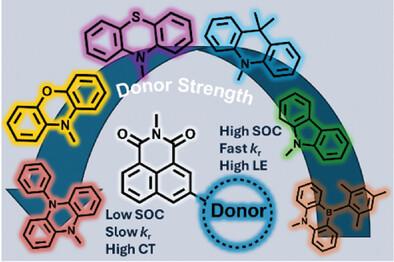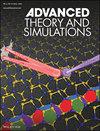C3 Substituted Naphthalimide Derivatives as Promising TADF Emitters: Effect of Donor Strength Revealed by Computational Studies
IF 2.9
4区 工程技术
Q1 MULTIDISCIPLINARY SCIENCES
引用次数: 0
Abstract
Thermally activated delayed fluorescence (TADF) emitters are pivotal in enhancing the electroluminescence efficiency of organic light-emitting diodes (OLEDs) by enabling effective utilization of triplet excitons. Emitters based on naphthalimide (NI) have not received much attention, particularly the C3 substituted variants. In this study, a potential TADF molecule NI-AZB featuring 10-mesityl-5,10-dihydrodibenzo[b,e][1,4]azaborinine (AZB) as a donor is shortlisted after a rigorous consideration of several similar derivatives possessing donors such as carbazole, dimethylacridine, phenoxazine, and phenothiazine. Computational analyses indicate that NI-AZB exhibits a small singlet-triplet energy gap, promising radiative decay rates, moderate spin-orbit coupling, and substantial reverse intersystem crossing (rISC) rates. The S1 state of NI-AZB is charge-transfer (CT) in nature, while the T1 state exhibits localized excitation (LE), facilitating enhanced spin-orbit coupling and rISC rates. Additionally, NI-AZB absorbs in the UV region, suggesting its potential as a blue-emitting material for OLED devices. Furthermore, it is observed that substitution at the C4 of the naphthalimide core enhances CT character, leading to higher rISC rates but reduced radiative rates. Conversely, substitution at the C3 diminishes CT character, resulting in increased radiative rates while maintaining moderate rISC rates. These insights underscore the importance of C3 substitution in optimizing TADF properties of naphthalimide-based emitters for OLED applications.

通过有效利用三重激子,热激活延迟荧光(TADF)发射器在提高有机发光二极管(OLED)的电致发光效率方面发挥着关键作用。基于萘二甲酰亚胺(NI)的发光体尚未受到广泛关注,尤其是 C3 取代的变体。在本研究中,经过对咔唑、二甲基吖啶、吩噁嗪和吩噻嗪等几种具有供体的类似衍生物的严格考量,一种以 10-甲烷基-5,10-二氢二苯并[b,e][1,4]氮杂硼烷(AZB)为供体的潜在 TADF 分子 NI-AZB 被列入候选名单。计算分析表明,NI-AZB 具有较小的单线-三线能隙、良好的辐射衰变率、适度的自旋轨道耦合和可观的反向系统间交叉(rISC)率。NI-AZB 的 S1 态本质上是电荷转移(CT)态,而 T1 态则表现出局部激发(LE)态,有利于增强自旋轨道耦合和 rISC 速率。此外,NI-AZB 在紫外区有吸收,这表明它有潜力成为 OLED 器件的蓝色发光材料。此外,研究还发现,萘二甲酰亚胺核心 C4 处的取代会增强 CT 特性,从而提高 rISC 速率,但降低辐射率。相反,C3 处的取代会降低 CT 特性,导致辐射率增加,同时保持适度的 rISC 率。这些见解强调了 C3 取代在优化基于萘二甲酰亚胺的发光体的 TADF 特性以应用于有机发光二极管方面的重要性。
本文章由计算机程序翻译,如有差异,请以英文原文为准。
求助全文
约1分钟内获得全文
求助全文
来源期刊

Advanced Theory and Simulations
Multidisciplinary-Multidisciplinary
CiteScore
5.50
自引率
3.00%
发文量
221
期刊介绍:
Advanced Theory and Simulations is an interdisciplinary, international, English-language journal that publishes high-quality scientific results focusing on the development and application of theoretical methods, modeling and simulation approaches in all natural science and medicine areas, including:
materials, chemistry, condensed matter physics
engineering, energy
life science, biology, medicine
atmospheric/environmental science, climate science
planetary science, astronomy, cosmology
method development, numerical methods, statistics
 求助内容:
求助内容: 应助结果提醒方式:
应助结果提醒方式:


